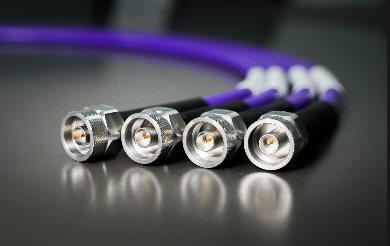Coaxial Cable Assembly Attachment Methods
RF coaxial cable assemblies consist of a coaxial cable and one or more RF coaxial connectors terminating one or both ends. There are a wide range of both coaxial cable and coaxial connectors. Amongst the variation in coaxial connectors is the method in which the coaxial cable is attached to the coaxial connector. There are three main attachment methods: crimp method, compression method, and solder method. Compression method is not as common as the crimp or solder method for RF applications outside of TV/broadcast and other niche high volume applications. Hence, this method will only be mentioned here.The coaxial cable assembly attachment method is generally dictated by design features of the coaxial connector and compatibility of the coaxial cable itself. In order to attach a coaxial connector to a coaxial cable, the coaxial cable first needs to be prepared for the attachment. This typically requires trimming back the dielectric from the center conductor, trimming the outer shielding/outer conductor back from the dielectric, and trimming back the outer jacketing material from the outer shielding/outer conductor. The lengths and quality of this trimming is generally specified in the coaxial connector data sheet. There are some specialized tools designed with certain common coaxial connector and cable combinations in mind that can make this process less labor intensive and repeatable.
Crimp MethodThe crimp method consists of using crimping tools with the appropriate crimp die and ferrule/contact to crimp the coaxial connector center contact to the center conductor of the coaxial cable. Similarly, a crimp tool is also used to crimp a ferrule/contact to the outer conductor/shielding and jacketing material of the coaxial cable to the outer conductor/housing of the coaxial connector. Exactly how these operations are performed depends on the design of the coaxial connector. Typically, the crimping method deforms the ferrule or crimp section of the contact adequately to form a strong mechanical and electric connection to elements of the coaxial cable without crushing or otherwise significantly deforming them. Hence, a precise crimp die is typically needed for a coaxial cable and connector combination to avoid under-crimping, over-crimping, or deformation of the coaxial cable assembly elements.
Generally, properly crimped connections are moisture and debris barriers and provide a rugged mechanical connection resilient to shock and vibration. However, under repeated flexure or over-bending, center conductor strands could become loose within the center contact crimp section, which may lead to degradation or failure of the connection.
Solder MethodThe solder method relies on using molten solder to provide an electrical and mechanical connection between the center contact and coaxial cable center conductor and sometimes the outer shielding/conductor and outer conductor/housing of the coaxial connector as well. This method generally only requires a soldering iron and simple set of coaxial connector elements, such as the center contact and outer housing. This is opposed to a crimp connector which may involve several parts including contacts, ferrules, seals, and other components to ensure alignment and good connection during crimping. The solder method, if done well, can be extremely high performing and allow for a much wider range of coaxial cable and connect compatibility than with crimp attachment connectors.
The main drawback to the solder method is that it requires a skilled assembly operator and generally longer assembly times than with crimped connections. The solder method is compatible with flexible, semi-rigid/semi-flex, and rigid coaxial connectors.



